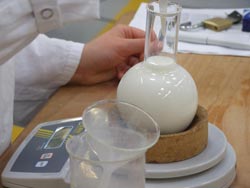Gentle pasteurization of milk – with microwaves

Analysis of pasteurized milk in the laboratory. <br>© Fraunhofer IGB <br>
Hereby, cold milk is first preheated and then further heated in a separate section for a few seconds up to 72°C. The major microorganisms present in the milk are destroyed during this process and as a result, the milk can be kept consumable for up to 10 days.
Currently, the milk is pasteurized by using plate heat exchangers in which preheated milk is passed in countercurrent to hot water or steam. The heat recovered from the subsequent cooling of the pasteurized milk is used to heat the incoming cold milk.
However, direct heating using plate heat exchangers has disadvantages: heat transfer is weakened by a process known as fouling, in which the heating time is extended by formation of an undesirable layer on the large surfaces of the heat exchanger.. They must therefore be cleaned regularly. Here, energy, water and detergents are required.
In the EU project MicroMilk, coordinated by the Fraunhofer Institute for Interfacial Engineering and Biotechnology IGB, different partners have developed a system that enables the preservation of milk and milk products with microwaves. A prototype for continuous microwave-pasteurization with a throughput of 400 liters of milk per hour has been integrated into an existing pasteurization process at a dairy station at the University of Hohenheim.
In experimental operation, great advantages have been shown. Reduction of fouling has enabled extended operating times between system cleansings, thus additionally saving water. Milk heating with a pasteurization step from 68°C to 72°C not only results in a more homogeneous temperature gradient, but is also three times faster than with a plate heat exchanger.
Due to this extremely rapid, almost sudden heating (“flash heating”), the milk is exposed to high temperatures only for very short time. “Much of the valuable and heat-sensitive substances, especially milk proteins and vitamin B remains undenaturated,” explains Dr. Ana Lucia Vásquez, who coordinates the project at the IGB. “A very promising characteristic of microwave pasteurization is that we can also handle viscous products with a high content of solids, such as whey concentrates,” Vásquez says. “Existing pasteurization plants are susceptible to fouling and have to be cleaned frequently.”
The core of the microwave method and a result of extensive simulation is a compact reactor, which is divided into different compartments. Each compartment is equipped with its own magnetron generating electromagnetic waves. The microwaves are coupled into a waveguide, which simultaneously acts as the heating chamber. Through this chamber, the milk flows in a special pipe. The pipe material does not absorb the microwaves, but is resistant against heat and pressure. Vásquez describes the principle:”During this passage, the milk is heated directly, and, unlike the plate heat exchanger, it is not heated from the outside to the inside, but volumetrically: when the electromagnetic waves are absorbed by the polar molecules of the milk, this makes the molecules oscillate over the entire volume and thus homogenously generating heat.”
To provide the operational economics and to establish the system in the market, the process is now to be demonstrated with two industrial scale units within the follow-up project MicroMilk Demo. Dairies with a relatively small throughput can integrate the new microwave module into their existing plate heat exchanger system; the flexible microwave-pasteurization system enables discontinuous operation, allowing the processing of small throughputs to remain profitable. For this purpose, a microwave unit with a flow rate of 2,000 liters per hour is designed. The unit is specifically designed for the flash-heating of milk from ca. 67°C to 72°C, replacing the conventional heat exchanger and the associated heating circuit for pasteurization. However, the regeneration stage for heat recovery remains unaltered. “This makes the pasteurization system profitable for small dairies, since the system does not require a separate heating circuit or boiler for the start-up,” explains Vásquez.
The second microwave-pasteurization unit to be built has a flow rate of 1,000 liters per hour and will be tested to treat especially high viscous products such as condensed milk and whey concentrates, as well as products with a high content of solids such as fruit yogurt, fruit juice and fruit puree. This system is expected to operate without fouling formation and to heat dairy products to a wide temperature range of 60°C; fouling-prone plate heat exchangers will not be used.
Since September 2013, “MicroMilk-Demo – Demonstration of a novel microwave processing application for nutritional and shelf stable milk” is being funded within the scope of the 7th Framework Research Programme of the EU (Grant Agreement No. 606321). The project partners are the SMEs C. Van’t Riet Dairy Technology (Netherland), Dantech UK Ltd. (Great Britain), Malthe Winje Automasjon AS (Norway) and Schwarzwaldmilch GmbH Freiburg (Germany) with research partners the Fraunhofer IGB and University of Hohenheim.
Media Contact
All latest news from the category: Process Engineering
This special field revolves around processes for modifying material properties (milling, cooling), composition (filtration, distillation) and type (oxidation, hydration).
Valuable information is available on a broad range of technologies including material separation, laser processes, measuring techniques and robot engineering in addition to testing methods and coating and materials analysis processes.
Newest articles

Largest magnetic anisotropy of a molecule measured at BESSY II
At the Berlin synchrotron radiation source BESSY II, the largest magnetic anisotropy of a single molecule ever measured experimentally has been determined. The larger this anisotropy is, the better a…

Breaking boundaries: Researchers isolate quantum coherence in classical light systems
LSU quantum researchers uncover hidden quantum behaviors within classical light, which could make quantum technologies robust. Understanding the boundary between classical and quantum physics has long been a central question…

MRI-first strategy for prostate cancer detection proves to be safe
Active monitoring is a sufficiently safe option when prostate MRI findings are negative. There are several strategies for the early detection of prostate cancer. The first step is often a…



